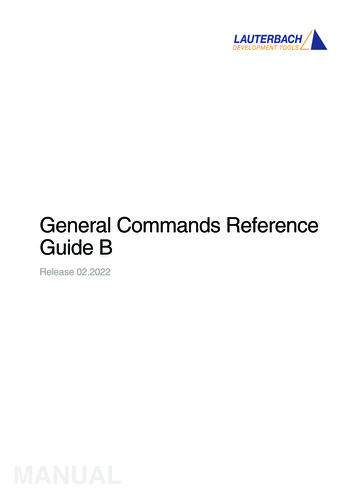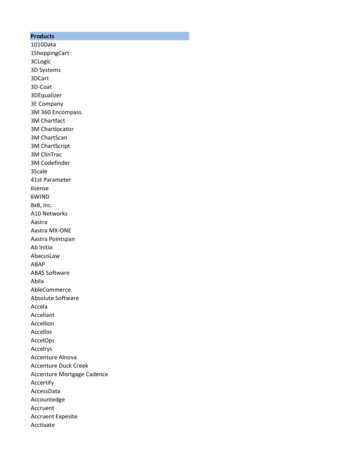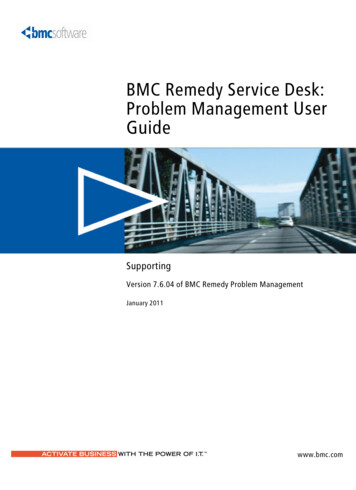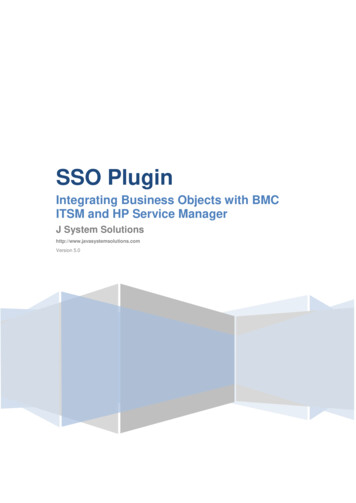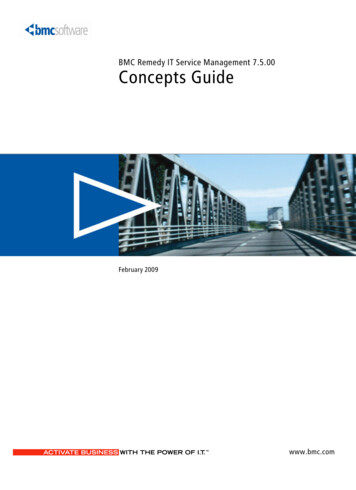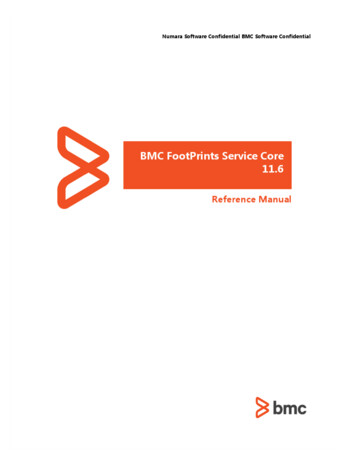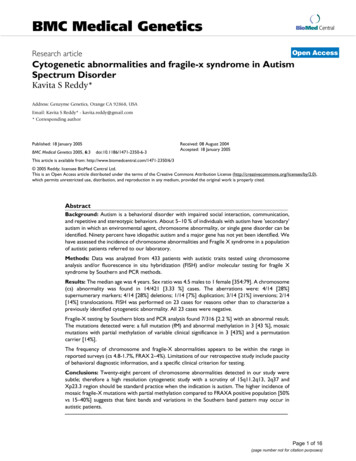
Transcription
BMC Medical GeneticsBioMed CentralOpen AccessResearch articleCytogenetic abnormalities and fragile-x syndrome in AutismSpectrum DisorderKavita S Reddy*Address: Genzyme Genetics, Orange CA 92868, USAEmail: Kavita S Reddy* - kavita.reddy@gmail.com* Corresponding authorPublished: 18 January 2005BMC Medical Genetics 2005, 6:3doi:10.1186/1471-2350-6-3Received: 08 August 2004Accepted: 18 January 2005This article is available from: http://www.biomedcentral.com/1471-2350/6/3 2005 Reddy; licensee BioMed Central Ltd.This is an Open Access article distributed under the terms of the Creative Commons Attribution License (http://creativecommons.org/licenses/by/2.0),which permits unrestricted use, distribution, and reproduction in any medium, provided the original work is properly cited.AbstractBackground: Autism is a behavioral disorder with impaired social interaction, communication,and repetitive and stereotypic behaviors. About 5–10 % of individuals with autism have 'secondary'autism in which an environmental agent, chromosome abnormality, or single gene disorder can beidentified. Ninety percent have idiopathic autism and a major gene has not yet been identified. Wehave assessed the incidence of chromosome abnormalities and Fragile X syndrome in a populationof autistic patients referred to our laboratory.Methods: Data was analyzed from 433 patients with autistic traits tested using chromosomeanalysis and/or fluorescence in situ hybridization (FISH) and/or molecular testing for fragile Xsyndrome by Southern and PCR methods.Results: The median age was 4 years. Sex ratio was 4.5 males to 1 female [354:79]. A chromosome(cs) abnormality was found in 14/421 [3.33 %] cases. The aberrations were: 4/14 [28%]supernumerary markers; 4/14 [28%] deletions; 1/14 [7%] duplication; 3/14 [21%] inversions; 2/14[14%] translocations. FISH was performed on 23 cases for reasons other than to characterize apreviously identified cytogenetic abnormality. All 23 cases were negative.Fragile-X testing by Southern blots and PCR analysis found 7/316 [2.2 %] with an abnormal result.The mutations detected were: a full mutation (fM) and abnormal methylation in 3 [43 %], mosaicmutations with partial methylation of variable clinical significance in 3 [43%] and a permutationcarrier [14%].The frequency of chromosome and fragile-X abnormalities appears to be within the range inreported surveys (cs 4.8-1.7%, FRAX 2–4%). Limitations of our retrospective study include paucityof behavioral diagnostic information, and a specific clinical criterion for testing.Conclusions: Twenty-eight percent of chromosome abnormalities detected in our study weresubtle; therefore a high resolution cytogenetic study with a scrutiny of 15q11.2q13, 2q37 andXp23.3 region should be standard practice when the indication is autism. The higher incidence ofmosaic fragile-X mutations with partial methylation compared to FRAXA positive population [50%vs 15–40%] suggests that faint bands and variations in the Southern band pattern may occur inautistic patients.Page 1 of 16(page number not for citation purposes)
BMC Medical Genetics 2005, 6:3BackgroundIn 1943 Kanner coined "infantile autism" (autism derivedfrom Greek autos, or self) after observing 11 children,mostly boys, on the basis of their social isolation. Autism,often referred to as autistic disorder or infantile autism, isa complex behavioral disorder, which, by definition,develops prior to age three. Autism is defined completelyon the basis of impairments in social interaction and communication, repetitive and stereotypic behaviors. Recentresearch has examined autistic traits in a population oftwins and found that social impairment actually follows aunimodal distribution without a clear demarcation toseparate cases of the disorder [1]. For this reason, futurediscussion of autism may be referred to as autism spectrum disorder (ASD) [2].For most children, the onset of autism is gradual; however, about 30% have a "regressive" onset. Fifty to seventypercent of children with autism are defined as mentallyretarded by nonverbal IQ testing. Seizures develop inabout 25% of children with autism. About 25% of children who fit the diagnostic criteria for autism at age twoor three years subsequently begin to talk and communicate, and by six or seven years blend to varying degreesinto the regular school population. The remaining 75%continue to have a life-long disability requiring intensiveparental, school, and societal support. There are no biologic markers, therefore the standard criteria, compiled bythe American Psychiatric Association Manual of Psychiatric Diseases, 4th edition (DSM-IV), is the primary diagnostic reference used in the United States for autism. Thecauses of autism can be divided into "idiopathic," whichcomprises the majority of cases, and "secondary," inwhich an environmental agent, chromosome abnormality, or single gene disorder can be identified. About 5–10% of individuals with autism can be diagnosed withsecondary autism; the remaining 90–95% have idiopathicautism. About 30% of children with idiopathic autismhave complex autism, defined by the presence of dysmorphic features or microcephaly or a structural brain malformation [3]. About 70% of children with idiopathic autismhave essential autism, defined as the absence of physicalabnormalities.A recent CDC case-finding study in Brick Township, NewJersey reported prevalence at 40 per 10,000 for autism [4].While the latest epidemiologic study from the UnitedKingdom utilizing specialized visiting nurses who monitored child health and development at seven months, 18to 24 months, and three years of age reported a prevalencerate of 16.8 per 10,000 for autism [5]. The sex ratio forautism has been estimated at 4 males:1 female d related limbic and cortical structures. The cerebellummay also form part of a distributed neuronal networkresponsible for social cognition and communication.Serotonin is the neurotransmitter implicated in autism [8]The single gene disorders in which secondary autism isobserved include fragile X syndrome, tuberous sclerosis,phenylketonuria, Rett syndrome [3,9], Sotos, Neurofibromatosis I, Joubert syndrome [10], and Smith-LemliOpitz syndrome [11]. Risk to sibs of idiopathic cases is 75times greater than the prevalence in the general population [7] and higher concordance for autism amongmonozygotic (60–90%) than dizygotic (0–10%) twins[12] argue for a genetic predisposition to idiopathicautism. Multiple independent whole genome scans andchromosomal abnormalities studies have pointed out several candidate regions on chromosomes 2q, 3q, 7q, 6,13q, 15q, 16p, 17q and sex chromosomes. These regionspossess candidate genes that have been screened for mutations or association with autism [13]. However, a clearinvolvement of a major susceptibility gene (or genes) inautism remains far from clear. The results from linkagestudies and the drop in the concordance rates betweenmonozygotic and dizygotic twins suggests that the geneticetiology of autism is certainly heterogeneous (differentgenes in different families), polygenic (more than oneaffected gene per individual) with epigenetic influencesand allelic heterogeneity (different variants in the samegene may lead to different patterns of genetic disease) [1315].To gain further insight into secondary autism we havecompiled data on patients with autistic traits tested forfragile-X syndrome using molecular methods and chromosome abnormalities using cytogenetic analysis andFISH.MethodsA search was initiated using the key word autism in theindication field of the Genzyme Genetics, Orange laboratory database. For each case the electronic data and/orfiles were reviewed. The referral center, age, sex, karyotype,fluorescence in situ hybridization (FISH) and fragile Xresults were extracted and tabulated.Table 1: Demographics of the ASD patients testedDemographicsPatients with ASD referred for genetic testing 433Median age 4 yearsSex ratio 4.5 males to 1 femaleSocial cognition and communication in autism may berelated to dysfunction in the amygdala, hippocampus,Page 2 of 16(page number not for citation purposes)
BMC Medical Genetics 2005, 6:3http://www.biomedcentral.com/1471-2350/6/3Table 2: The chromosome abnormality found in 3.33 % (14/421) patients with an indication of autismSl #AgeSexClinical IndicationChromosome ResultFISH ResultFragileX Result.ish der(2)(D2Z ).ish der(15)(D15Z ,D15S11 ,GABRB3 ).ishi(15)(q11.2)(rRNA ,D15Z ,D15S11-).ishder(15)(rRNA ,D15Z ,D15S11 ,GABRB3 ).NRMNT.ishdup(15)(q12)(D15S11 ,GABRB3 )denovoNT.ish del(2) (q37.3)(D2S447-)NT46,XX,del(3)(p25) de novo46,XY,del(12)(q21.2q23.3).ish 12(wcp12x2)NTNRM46,XY,del(13)(q13.2q14.1)de novo.ish ker 4/14 28%126.15MFAutismAutism47,XY, mar[27]/46,XY[3]47,XX, mar33MAutism47,XY, mar de novo45.1FAutism, MRmos47,XY, r[15]/46,XX[15]NTNTDuplication 1/14 7%516.75FAutism46,XX,dup(15)(q11.2q13)de novoDeletion 4/14 28%66.5F786.611.7FM93.6MAutism, DD, MR,macrocephalyAutism, DDAutism, DD, MR, multiplecongenital abnormality, h/o DSAutismInversion 3/14 21%10112.83.5FMAutismAutism123.25MAutism, hypotonia, q33)[3]/46,XY[17]*46,XY,add(17)(q23) orinv(17)(q23q25)de novoTranslocation 2/14 )46,XY,der(14;18)(q10;q10)DD developmental delay, MR mental retardation, DS Down syndrome, NT not tested NRM normal *inv(10) is a normal familial variantand inv(14) is a frequently observed artifact of cultureG-banded metaphases were prepared using standard procedures and FISH was performed using the protocol provided by the manufacturer of the commercial probes(Vysis Inc., Illinois, MI).Fragile X test: Isolated DNA was tested by both Southernblot analysis and Polymerase chain reaction (PCR) for thesize and methylation status of the CGG repeat expansionwithin the FMR-1 gene. Southern blot analysis was performed with the probe StB12.3 on EcoR1 and Eag1digested DNA. PCR products were separated by acryla-mide gel electrophoresis and detected with a CGG repeatprobe.ResultsPatients with autistic traits were referred by physicians toour laboratory for genetic testing. The clinical diagnosticcriteria applied were not specified on the test requestforms.A total of 433 patients with an indication of autism weresent to our laboratory for genetic diagnosis. The medianPage 3 of 16(page number not for citation purposes)
BMC Medical Genetics 2005, 6:3http://www.biomedcentral.com/1471-2350/6/3Table 3: Summary of FISH casesSl #Age in SexyearsClinical IndicationKaryotypeFISHNormal ish 7q11.23(ELNX2)Normal ish 7q11.23(ELNX2)Normal ish 7q11.23(ELNX2)Normal ish 22q11.2(TUPLEx2)Normal ish 22q11.2(TUPLEx2)Normal-ish 22q11.2(TUPLEx2)Normal-ish 22q11.2(TUPLEx2)Normal-ish 22q11.2(TUPLEx2)Normal, ish 15q12(D15S11x2)Normal, ish 15q12(D15S11x2)Normal, ish 15q12(D15S11x2)Normal, ish 15q12(D15S11x2)Normal-ish 15q12(D15S11x2)Normal ish 15q12(D15S11)Normal, ish 15q12(D15S11x2)Normal- subtelomere Normal, subtelomeres Normal, ish15q12(D15S11x2)Normal ish 15q11.2q13(D15S11x2),17p11.2(SMSx2), 225.25 M7 MM3.6 M6.3 M3.5 MMM6.5 M11.6 M3.5 M3 M2 M2.5 F3.6 M3.5 M3.5 F4.6 M8.6 MM2.7 M16 MAutismAutism, FTT, MR, DDAutismAutism, DD, hypocalcemia, cardiac defect, MRAutism, DD, hypotoniaAutismAutismAutismAutism, DD, MRAutism, DDAutismAutismAutism, DD,MRAutism, DD,MRAutism, DD, patch hyperpigmentationAutism, DD, seizuresAutism, DDAutism, DDAutism, DDAutismAutismAutism, DD, dysmorphic features, MR46,XY46,XY46,XY46,XY46,XYnot XY46,XY46,XX46,XY46,XY46,XY46,XY46,XY2317.5 RMNRMNRMABNM male, F female, NRM normal, ABN abnormal, DD development delay, MR mental retardation, FTT failure to thrive.age was 4 years. Sex ratio was 4.5 males to 1 female[354:79] (Table 1). A chromosome abnormality wasfound in 14/421 [3.33 %] cases. A Fragile-Xq27.3 wasdiagnosed in 7/316 [2.2 %].Chromosome abnormalities are summarized in Table 2:The aberrations were: 4/14 [28%] supernumerary markersfrom cs 15 [3] and cs 2 [1] (Fig 1a); 4/14 [28%] deletionsof 2q37.3, 3p25, 12q21.2q23.3 and 13q13.2q14.1(Fig1b); 1/14 [7%] duplication of 15q11.2q13; 3/14 [21%]inversions of 10p11.2q21.2, 17q23q25 (de novo) and14q11.2q33 (mosaic) (Fig 1c); 2/14 [14%] translocations,one balanced t(1;14) and one unbalanced der(14;18) (Fig1d).The 3/4 marker/ring had a 15 centromere signal by FISHand had either nil, one or two signals for D15S11, thatdemarcates the involvement of the critical region ofPrader Willi/Angelman syndrome (Table 2).Fluorescence in situ hybridization was performed on 23of 433 patients for reasons other than to characterize acytogenetic abnormality, 3 to rule out Williams-BeurenSyndrome, 5 for DiGeorge syndrome, 7 for proximalduplication of D15S11, 6 for subtelomere rearrangements, 1-for subtelomere rearrangement & proximalduplication D15S11 and 1 for duplication D15S11,Smith-Magenis Syndome, and DiGeorge Syndrome. All23 FISH tests were negative (Table 3).Fragile X (Table 4): The mutations detected were: A fullmutation (fM) and abnormal methylation in 3 [43 %]and mosaic mutations with partial methylation of variable clinical significance in 3 [43%]. The mosaic size mutations were: an fM [200–900 repeats(r)] / deletionmutation [30 r] with partial methylation. The faint bandsfor the full mutation and deletion mutation may be areflection of the sample quality (Fig 2, Lane 5). Two sizemosaics had permutation (pM) [150 r]/fM [400 r] (Fig 2),and pM [155 r]/fM [800 r] with normal and abnormalmethylation. A premutation mosaic female carrier with anatypical EcoR1 and Eag1 pattern and a typical BssH1 pattern gave 2.8, 3.0, 5.2–5.4 Kb bands, the Eag1 pattern suggested a DNA sequence change [14%]. PCR gavereproducible bands corresponding to 29, 65, 80 repeatsand a faint band for 39 repeats. Intermediate mutation(45–54 r) was found in 5 males and 2 females.Page 4 of 16(page number not for citation purposes)
BMC Medical Genetics 2005, ren with Down syndrome have autism more commonly than expected. The incidence was at least 7 % inone study [18]. This finding suggests that chromosomeabnormalities may lower the threshold for the expressionof autism.In our study (4/14 28 %) and in other surveys, the common recurring chromosomal abnormality was duplication of the proximal 15q region (Table 5). About 1% ofindividuals with ASD have a chromosomal duplication inthe Prader-Willi/Angelman region of proximal 15q[[19,20], present study 4/421[0.95%]]. The duplicatedregion q11.2q13 is on the maternal chromosome 15 inautistic patients [21-23]. Most commonly, this is a supernumerary isodicentric 15q chromosome detectable byroutine cytogenetic studies or, less commonly, an interstitial duplication of the region detected by FISH analysis forthe SNRPN gene region. These two chromosome abnormalities have only subtle effects on the physical phenotype. Supernumerary isodicentric 15q chromosomes arede novo occurrences. Duplication of proximal 15q mayresult from segregation of a parental chromosome translocation or an interstitial 15q duplication. An abnormalgene dosage within 15q11.2-q13 might cause susceptibility to autism.Figure fragileMosaicStB12.3digested2onDNAEcoR1X mutations:and Eag1 Southern(methylation-sensitiveblot using probeenzyme)Mosaic fragile X mutations: Southern blot using probeStB12.3 on EcoR1 and Eag1 (methylation-sensitive enzyme)digested DNA. Lane 1 – permutation carrier, Lane 2 & 3 –normal female, Lane 4 – normal male, Lane 5 – an ASD malemosaic with fm (3.7 and 5.8–7.9 kb, 200–900 r)(arrows)/adeletion mutation (2.8 kb faint band, 30 r)(arrow). By PCR a30 repeats and 200 repeats were amplified. Lane 6 – anASD male mosaic fm (6.4 kb, 400 r)/pm (3.3 kb, 150 r).DiscussionChromosomal causes of secondary Autism SpectrumDisorder (ASD)About 1.7 % to 4.8 % of individuals with ASD have chromosome abnormalities, including unbalanced translocations, inversions, rings, and interstitial deletions andduplications (Table 5). The chromosome abnormalitiesthat have been reported on more than one occasion areduplication of 15q, deletions of 18q, Xp, 2q and the sexchromosome aneuploidies 47,XYY and 45,X [16].A recent FISH subtelomere study found one out of tenunselected patients with ASD had a subtelomeric 2qterdeletion [17]. In our experience 7/7 ASD patients werenegative for subtelomeric rearrangements.The 15q11-q13 region is shown schematically in Figures 3&4. Chromosome 15q11.2-q13 has gained support as anautism candidate region on the basis of the association ofmaternally derived chromosomal duplications of thisregion with an autistic phenotype [20,24-27] and geneticevidence for linkage and allelic association in the sameinterval in chromosomally normal autism families [2834]. The maternal specificity of chromosome 15 duplications in autism suggests a genomic imprinting effect.There are multiple imprinted genes in 15q11.2-q13, andtwo neurodevelopmental disorders exhibiting oppositepatterns of genomic imprinting have been mapped to thisregion [35-37]. Interstitial deletion of 15q11.2-q13specific for the paternal chromosome is the most frequentcause of Prader-Willi syndrome (PWS; MIM 176270),whereas maternal-specific deletion of the same commoninterval results in Angelman syndrome (AS; MIM105830). The converse of Angelman Syndrome isobserved in autism, that is a maternal duplication. Thefour causes of Angelman syndrome are 1) maternal deletion of 15q11.2q13, 2) paternal UPD15 3) mutations inUBE3A 4) mutations leading to imprinting errors of thisregion. A population-based study showed a high rate ofASD in AS [38]. But, a mutation was not identified in theUBE3A putative promoter or coding region in 10 idiopathic ASD patients [39]. Lack of expression of the maternally expressed UBE3A gene in the brain is thought to bethe cause of AS. Since patients with deletions compared toother types of AS mutations have a more severePage 5 of 16(page number not for citation purposes)
BMC Medical Genetics 2005, re 1Chromosomeabnormalities in patients with autistic traits (A) 4 markersChromosome abnormalities in patients with autistic traits (A) 4 markers: [multiple copies] derived from chromosome 2 [1], 15[3] with nomenclature (B) 1 duplication of chromosome 15 with arrow denoting the region involved (C) 3 partial deletions(right homolog)(multiple copies) of 3p25, 12q21.2q23.3 & 13q13.2q14.1 with the ideogram, the arrows denote the deletedregion. (D) 3 inversions (the right homolog) (multiple copies), inv(10)(p11.2q21.2), inv(14)(q11.2q32), inv(17)(q24.2q25.3) witharrows on the ideogram showing the inverted region (E) 2 translocations (partials in 2 copies, chromosomes involved (right)and their normal homolog (left)) one apparently balanced t(1;14)(q25;q31.2) and one unbalanced der(14;18)(q10;q10). The ideogram with arrows show the breakpointsPage 6 of 16(page number not for citation purposes)
BMC Medical Genetics 2005, 6:3http://www.biomedcentral.com/1471-2350/6/3Table 4: The details of Fragile X mutations found in 2.2 % (7/316) patients with a clinical indication of autismSl #Age InyearsSexClinical indicationFRAXA ResultMethylationChrom FISHResult ResultFull mutation 3/7 43%1234.554.5MMMAutismAutismAutism, DDABN-Full mutation (400,533,667repeats [r])ABN-Full mutation (600–1100 r)ABN- Full mutation (267–933 r),abnormal methylation 46,XYabnormal methylation 46,XYabnormal methylation 46,XYNTNTNTNormal & abnormalmethylationNormal & abnormalmethylationpartial methylation46,XYNT46,XY46,XYNormal-sub telNT46,XXNTMosaic mutation 3/7 43%42.3MAutism51.7MAutism68.5MAutism, DDABN-size mosaic Full mutation [800 r]/ premutation[155 r]ABN-size mosaic Full mutation [400 r]/ premutation[150 r]ABN-mosaic Full mutation [200–900 r]/ deletionmutation [30 r],Mosaic Premutation carrier 1/7 14%76Av 4.36yearsF2F,5MAutismABN- premutation mosaic [29,65,80,39(light band)r]Intermediate mutation 7 cases with 45–54rDD developmental delay, NT not testedphenotype, suggests the involvement of additional genelosses, such as GABAA receptor gene cluster [40]. Transcripts increased in patients with duplications15q11.2q13 are maternal UBE3A [41], maternal ATP10C[40,42] and other transcripts including antisense transcripts that could regulate gene expression [43] and maycontribute to the duplication phenotype. Therefore, overexpression of genes in 15q11-q13 probably confers ASDrisk. Region proximal to D15S11 is considered to have nophenotypic effect. However, one of our patients had amarker 15 negative for D15S11, therefore, some duplications of 15, proximal to D15S11 and the autism candidateregion may also influence susceptibility to autistic traits.Initial studies to characterize the phenotype of15q11.2q13 duplication patients have found variationamong affected people including mental retardation,motor coordination problems, seizure disorder, andimpairments in attention, communication, and socialfunction (some but not all with ASD or attention deficithyperactivity disorder (ADHD)) [44,45]. It appears theremay be a parent-of-origin effect on the linkage and association signals in this region of UBE3A and ATP10C[46,32,33]. Further studies across data sets, and rigorousevaluation of potential functional effects of associatedalleles, and a thorough assessment of haplotypetransmission within ATP10C and neighboring geneswould be conclusive. The majority of linkage and association data point to the GABRB3 gene, which is one of acluster of γ-aminobutyric acid (GABA) receptor subunitsthat map to the distal, apparently nonimprinted segmentof the duplicated region (Fig. 3). Although a number ofgroups have detected genetic effects at GABRB3 in independent autism populations [29-31], other studies havefailed to replicate these observations [47-49].Yardin et al 2002 [50] recommended a systematic screening by FISH, of chromosome region 15q11.2q13 in caseswith autistic-like syndromeA deletion of 2q37.3 was identified by FISH in a patientwith autism and macrocephaly in our study. Wolff et al2002 [51] also reported an autistic patient with a 2q37.3deletion detected using subtelomere probes. Wholegenome screens have suggested several chromosomalregions that are potentially associated with a susceptibilitygene for autism. [52-57]. Three studies revealed positivelinkage to 2q [52,53,57] and a third study demonstratedlinkage to distal 2q in a subset of patients with autism anddelayed onset of phrase speech [53]. Genomic scans arelimited by the number of loci that are assessed; therefore,not all areas may be equally represented. It is important tonote that telomeric regions may have increased meioticrecombination and may be under-represented in thesetypes of analyses. Thus, the FISH approach is an importantcorrelative study in the search for susceptibility genes.Macrocephaly in ASD: most children with autism are bornwith normal head circumference and about 20% meet thePage 7 of 16(page number not for citation purposes)
BMC Medical Genetics 2005, 6:3http://www.biomedcentral.com/1471-2350/6/3Table 5: Summary of reported population studies to assess the frequency of chromosome abnormalities (excluding fragile sites,polymorphisms and single cell abnormalities)StudySubjectskaryotypedChromosome abnormalityClinical diagnosisKonstantareas & Homatidis 1999[123]1276 [4.7%]Diagnosed using the clinical criteria of autisticdisorder by DSM-III (1983–1989)4646,XY,inv(2)(p11q13)pat,3q 47,XY, mar47,XY, mar47,XX, 1347,XX, inv dup(15)(pter q13::q13 pter)47,XY, der(15)(pter q15::p11 pter)de novo2 [4.3%]14547,XY, 2147,XYY4 [2.8%]10447,XX, (p11.21;q21.2)mat46,XY,t(7;12)(q21.4;q15)de novo5 [4.8%]Gillberg & Wahlstrom 1985[124]Lauritsen 1999 [122]Li 1993 [121]Weidmer-Mikhail 1998 [120]59Ritvo 1990 [6]233Wassink 2001 [119]27847,XY, 2146,XY/47,XY, 21 [12/88]46,XY,t(5;6)(q13;p23)de q11)1 [1.69 %]Tetrasomy 159 [3.9%]6-trisomy 21Partial trisomy 8Deletion 9p46,XX,t(5q;11q)pat13 [4.7 47,XX, mar de novo 47,XX, mar47,XY, )2–47,XX, 21Present42146,XY,add(22)(q13)14 [3.3%]Diagnosed using the American PsychiatricAssociation (1980) criteria DSM-IIICases with psychotic symptoms before 2–3 years orbeginning at 2–3 or later between 1969–1993Diagnosed using the American PsychiatricAssociation (1980 & 1987) guidelines, DSM-III & III-RDSM-III-R (1991–1995)DSM-III (1984–1988)DSM-III,-III-R & -IV (1980–1999)MR, diaphragmatic hernia, hemivertebra, 2-vesselumbilicus, strabismusMR, abnormal facies & palate, failure to thriveMR, abnormal EEG, precocious pubertyMild MR Moderate MR & SeizuresMcCune-Albright syndrome Microcephaly, abnormalfaciesMRMR, Seizures, failure to thrive, abnormal facies,webbed neck macrocephaly, syndactylyMR & abnormal faciesMR, heart murmur, esotropia, recurrent pneumonia.MR1VSD, pneumonia and seizuresMacrocephaly and failure to thrivePhysician referrals to a genetic lab. 1995–2003MarchPage 8 of 16(page number not for citation purposes)
BMC Medical Genetics 2005, e 3Chromosome15q11-q13 region showing the autism candidate regionChromosome 15q11-q13 region showing the autism candidate region. A schematic representation of the 15q11-q13 intervalduplicated in autism cases and deleted in Prader-Willi/Angelman syndrome is shown. IC denotes the position of the 15qimprinting center. Loci corresponding to previous reports of linkage and association are indicated by dark and light arrowheads, respectively, below the map. (Adapted with permission from Sutcliffe J et al article "Dense linkage disequilibrium mapping in the 15q11-q13 maternal expression domain yields evidence for association in autism' in Molecular Psychiatry (2003) 8,624–634)criteria for macrocephaly [58]. The increased rate ofgrowth in head circumference appears to be most dramatic in the first year of life and corresponds to increasedgrowth of the cerebral cortex as measured by MRI [59].A de novo deletion of chromosome 3, del(3)(p25), wasfound in one case with ASD and development delay in ourpatient pool. A deletion of 3q region was found by Konstantareas & Homatidis 1999 [60]. Genome wide scanfound a major susceptibility locus at 3q25-27 and therewas also allelic association in families with autism spectrum disorder originating from a subisolate of Finland[61,62]. Animal models and linkage data from genomescreens implicate the oxytocin receptor at 3p25-p26[61,62].To date, there have been no reports of 12q deletions inpatients with ASD, to the best of our knowledge. For thefirst time we report an interstitial deletion46,XY,del(12)(q21.2q23.3) in a patient with ASD, development delay, mental retardation, multiple congenitalabnormality, and family history of Down syndrome.46,XY,del(13)(q13.2q14.1)de novo was found in one ofour patients' with ASD. Hyperserotonemia in autism isone of the longest-standing biochemical findings. ThePage 9 of 16(page number not for citation purposes)
BMC Medical Genetics 2005, eThe map4location of D15S11 probe used to characterize the markersThe map location of D15S11 probe used to characterize the markersserotonin 2A receptor gene (HTR2A) on chromosome13q14q21 is a primary candidate gene in autism. Converging data from recent genome screens also implicatesthe genomic region containing HTR2A [63-66]. Correlation of HTR2A disruption or deletion in our case with a13q13.2q14.1 deletion and other 13q deletion in ASDpatients would complement genome screen data.The recent physical mapping of the serotonin 5-HT(7)receptor gene (HTR7) to 10q23 [67] raises the question ifthe inversion inv(10)(p11.2q21.2) present in our patient,which is considered a normal familial variant could havelong range influence on HTR7 and susceptibility to autismin some cases.So far there has been no observed association or linkbetween chromosome 14 and ASD. Also, the mosaicinversion inv(14)(q11.2q33) [3/20] found in one of ourpatients is considered a cultural artifact when seen in 1or2 cells.In this study, a patient with inv(17)(q23q25)de novo,had ASD, hypotonia and developmental delay. Chromosome 17q shows association with autism by genome widescans and in linkage studies [57,66,68]. There is also interest in 17q since serotonin transporter gene (SERT) hasbeen mapped to17q11-q12 [69].We report a patient with 18p deletion due to an unbalanced translocation between 14 and 18. Majority of thereported cases with autism involve deletion of 18q [70-Page 10 of 16(page number not for citation purposes)
BMC Medical Genetics 2005, 6:372]. A deletion of the 18p-arm (at band 11.3) in about50% cells and 50% of the cells with a duplication of thelong arm in peripheral blood was described in a mildlyobese girl with DSM-III-R autistic disorder and moderatemental retardation [73]. Another preschool girl withselective autism and a deletion of Chromosome 18p11.lhas also been described [74]. She had communicationproblems consistent with a diagnosis of autism. However,in the area of reciprocal social interaction she was a littleless deviant than most children and had no major behavior problems typical of autistic disorder. Linkage and association studies have suggested at least 2 candidate loci,one on the short and the other on the long arms of chromosome 18 [75].One of th
BioMed Central Page 1 of 16 (page number not for citation purposes) BMC Medical Genetics Research article Open Access Cytogenetic abnormalities and fragile-x syndrome in Autism Spectrum Disorder Kavita S Reddy* Address: Genzyme Genetics, Orange CA 92868, USA Email: Kavita S Reddy* - kavita.reddy@gmail.com * Corresponding author Abstract
